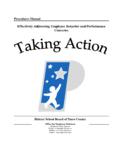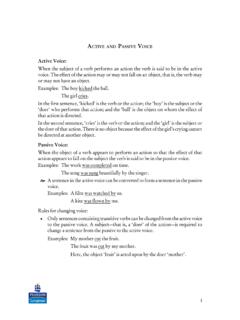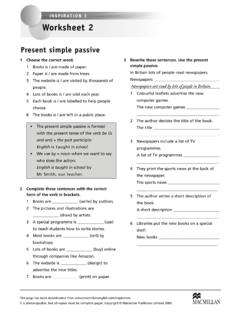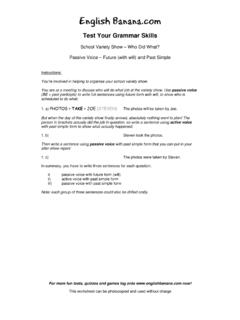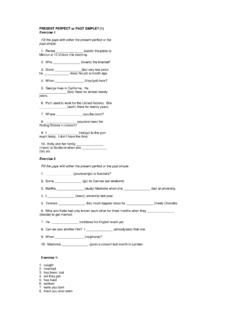Transcription of CONTENTS PAGE 1 - Pasco County Schools
1 2 CONTENTS PAGE 1 HOW TO TEACH GRAMMAR4 GENERAL: Two Peas in a Pod: 5 Tips to Integrate Grammar and Writing More Effectively 5 GENERAL: 5 New Fun Ways to Teach Grammar to ESL Students 6-7 GENERAL: How to Do a Comprehensive Review of Verb Tenses for Intermediate ESL Students 8 GENERAL: How To Teach Boring Grammar Points: 7 Quick Proven Tips 9 GENERAL: Quick Grammar Drills for Review and Practice 10 TENSES: Are You Tense About Tenses? 5 Tense Review Activities 11-12 TENSES: past , Present, Future: Teaching the Verb Tense System 13 TENSES: Verb Talk: Conversation Activities to Practice Using Verb Tenses 14 GRAMMAR IS FUN: How to Make Your Grammar Lessons a Little More Interesting15 USING PICTURES: Picture This: 5 Unique Ways to Practice Grammar Using Pictures 16 GRAMMAR DRILLS: How to Drill: Drilling Activities for Your English Classroom 17 TO BE: How to Teach the Verb To Be to Beginners 18-19 PRESENT simple : How to Teach Present simple to Complete Beginners 20 PRESENT simple : How to Teach the Present simple Tense 21 PRESENT PERFECT: How to Teach Present Perfect: Activities and Examples 22 PRESENT PERFECT.
2 How to Teach Present Perfect: Alternative Approach 23 PRESENT PERFECT: Present Perfect Mystery: How to Teach For and Since 24-25 PRESENT PERFECT: Where Have You Been? 5 Perfect Tips for Practicing Present Perfect 26 PRESENT CONTINUOUS: How to Teach the Present Continuous Tense 27 PRESENT CONTINUOUS: How to Teach Present Continuous: Alternative Approach 28 PRESENT PERFECT CONTINUOUS: How to Teach the Present Perfect Continuous Tense 29-30 PRESENT PERFECT VS past simple : How To Teach past simple VS Present Perfect 31 past simple : How to Teach past simple Regular/Irregular Verbs 32 past simple : How to Teach the past simple Tense Verb to Be 33 past simple : Where Did He Go? How to Teach Question-Making in past Tense 34 USED TO & WOULD: How to Teach Used To and Would 35 BE USED TO VS GET USED TO: I Can Never GET USED to Using USED TO: Ideas on How to Teach the Difference 36 past PERFECT: 3 Perfect Ways to Introduce past Perfect Tense 37 past PERFECT: How to Teach the past Perfect Tense 38 past CONTINUOUS: What Were You Doing When?
3 3 Great Activities for past Continuous Tense 39 past CONTINUOUS: How to Teach the past Continuous Tense 40 FUTURE TENSES: The Future May Future Tense Activities for Your Class 41 FUTURE simple : How to Teach the simple Future Tense3 CONTENTS PAGE 2 HOW TO TEACH GRAMMAR42 FUTURE CONTINUOUS: How to Teach the Future Continuous Tense 43 FUTURE PERFECT: How to Teach the Future Perfect Tense 44 REPORTED SPEECH: How to Teach Reported Speech - Statements 45 REPORTED SPEECH: How to Teach Reported Speech: Alternative Approach 46-47 REPORTED SPEECH: What Did She Say? Tips on Teaching Reported Speech 48 passive VOICE: The Man Was Robbed! Tips on When Using passive Voice is a Good Thing 49 passive VOICE: How to Teach passive Voice 50 passive VOICE: How to Teach the passive Voice While Being Active!
4 51 CONDITIONALS: How to Teach the Real, Unreal, and past Conditionals 52 CONDITIONALS: What Would You Rather? 6 ESL Activities for Reviewing the Conditional 53 MODAL VERBS: How to Teach Modal Verbs: 4 simple Steps 54 MODAL VERBS: 10 Teacher Tested Tricks to Teach Modal Verbs 55 MODAL VERBS: I Should Have Known: Teaching Modals of Regret 56 IMPERATIVE: How to Teach the Imperative Form 57-58 IMPERATIVE: Do This! Don t Do That! 8 Interactive Classroom Activities for Using the Imperative 59 IMPERATIVE: Following and Giving Directions: Using the Imperative 60-61 ARTICLES: America is THE Free Country? Teaching the Article System 62 WISHES & HOPES: I Dream Three Strategies for Teaching Wishes and Hopes 63 ADJECTIVES: Amazing Animals: A Super-Engaging Elementary Lesson on Adjectives 64 OPPOSITES: The 3 Little Wolves and the Big Bad Pig: Teaching Opposites 65 DEGREES OF COMPARISON: How to Teach Degrees of Comparison 66 DEGREES OF COMPARISON: How to Teach Comparatives and Superlatives 67-68 -ED AND -ING ADJECTIVES: 4 Fascinating Ways for Teaching -ED and -ING Adjectives 69 GERUND & INFINITIVE: I Like Swimming: 3 Tremendous Techniques for Teaching Gerunds and Infinitives 70 GERUND & INFINITIVE: Gerund vs.
5 Infinitive: How to Explain the Difference 71 HOW MUCH & HOW MANY: 3 Top Strategies to Alleviate Confusion About HOW MUCH and HOW MANY72 PREPOSITIONS: Turn Right, Go Left: Practicing Prepositions of Place73 PREPOSITIONS: How to Teach Prepositions of Time45 Tips to Integrate Grammar and Writing More EffectivelyA PREVALENT IDEA IN LANGUAGE CLASSROOMS TODAY IS THAT TEACH-ING GRAMMAR IN ISOLATION IS A BAD THING. While our students do need to learn grammar explicitly, the language learn-ing journey is more complicated than simple grammar rules. Students are good at doing grammar exercises, how-ever, when it comes to applying this grammar in their writing, they fall short.
6 Why? Most likely because we as teach-ers tend to teach writing and gram-mar as separate concepts. Below are some strategies to make writing more of a part of the grammar THESE 5 TIPS TO INTEGRATE GRAMMAR AND WRITING1 TAKE TIME TO READ IN WRITING CLASSAny time you can emphasize the crucial relationship between reading and writing will be beneficial for the students. When you introduce a gram-mar concept, show students a model paragraph or text which illustrates this concept nicely. For example, when teaching indirect/reported speech, you can take a news article and highlight the examples of indirect speech for the stu-dents to expose them to this new form. Ask students to study these bolded sen-tences, and ask why these sentences are written the way they are.
7 For indi-rect speech, you could show two cop-ies of the same article, one with direct speech and one with indirect speech. Alternatively, you can show students a text after you have introduced the gram-mar concept and ask them to find all of the examples of the rule you have just taught. While teaching past perfect, you can give students a story to have stu-dents compare and contrast past sim-ple and past perfect you use texts before instruc-tion or after, seeing grammar concepts in their appropriate and realistic context is critical for learners. If they can t un-derstand the patterns and situations in which this grammar is useful and ap-plicable, they will not be able to move beyond basic drills.
8 Seeing the featured grammar in others writing will empower students to be more confident in using the structures in their own WRITING PER DAY KEEPS THE ERRORS AWAYA fter introducing and practicing a grammar concept, give students a short informal writing to illustrate that grammar concept. Whether it is a paragraph or a full essay, immediate writing with a prompt aimed at eliciting the grammar structure will get students into producing the grammar more nat-urally than sentence drills. By writing more frequently, you are building their association between grammar and writ-ing. Also, emphasizing writing more than grammar in the classroom enforc-es the idea that language learning is not simply memorizing YOUR LESSONS WITH YOUR STUDENTS IN MINDEach time you evaluate student writing, jot down a few sentences from each stu-dent s paper that contain errors.
9 A good warm-up activity is to make a work-sheet based on student errors and go over them as a class. Remind students that everyone makes mistakes, even the teacher, and that each student has one error represented in the worksheet. After students have practiced correct-ing these errors, they can return to their writing to revise and is also beneficial to keep an error journal for your class. After you fin-ish reading an assignment from your students, make note of the common frequent errors among your students. These lists that you make should help inform your daily lessons to target the grammar your students still have not mastered.
10 4 DESIGN YOUR RUBRIC WITH GRAMMAR IN MINDT ypically speaking, students will write formal papers using only the grammati-cal structures with which they feel com-fortable. Rather than taking risks, stu-dents stay on the safe side and use simplistic sentences. To push them to practice using the more complex struc-tures that you ve been teaching in class, design your rubric to include specific points addressing which kinds of gram-matical structures you would like to approach is to tell students a mini-mum number of structures for each writing. For example, you might assign students a narrative essay in which they must use at least five examples of past perfect. Alternatively, you may wish to be less legalistic and implement a point system which rewards students for using target grammar.
